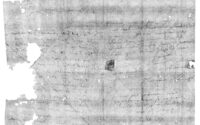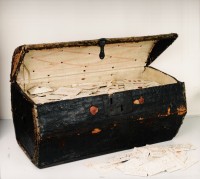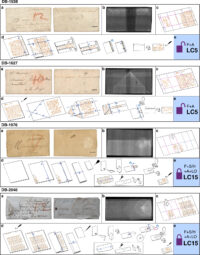X-ray microtomography (XMT), a scanning technology used in dental research, has virtually opened a letter that has been securely closed for 300 years. The technology more intense X-rays than CT scanners that are able to read the metals — iron, copper, mercury — in traditional inks. Once the volumetric dataset was produced, computer modeling was able to “unfold” the letter without damaging the document itself.
 Dated July 31, 1697, the letter was written by Jacques Sennacques of Lille to his cousin Pierre Le Pers, a merchant in The Hague, asking for a relative’s death certificate in flowery prose that fails to mask his impatience at how long cousin Pierre has been ghosting him.
Dated July 31, 1697, the letter was written by Jacques Sennacques of Lille to his cousin Pierre Le Pers, a merchant in The Hague, asking for a relative’s death certificate in flowery prose that fails to mask his impatience at how long cousin Pierre has been ghosting him.
Dear sir & cousin,
It has been a few weeks since I wrote to you in order to ask you to have drawn up for me a legalized excerpt of the death of sieur Daniel Le Pers, which took place in The Hague in the month of December 1695, without hearing from you. This is {…} I am writing to you a second time in order to remind you of the pains that I took on your behalf. It is important to me to have this extract you will do me a great pleasure to procure it for me to send me at the same time news of your health of all the family.
I also pray that God maintains you in His Sainted graces & covers you with the blessings necessary to your salvation. Nothing more for the time being, except that I pray you to believe that I am completely, sir and cousin, your most humble & very obedient servant,
Jacques Sennacques
I beg you to send your response to Mr Sennacques, king’s councillor in the bailiwick of Lille, Rue St Etienne in Lille
From Lille, the 31st of July 1697
The intricate folding of letters so they become their own secured envelopes, a practice known as letterlocking, was widely used before the introduction of the Uniform Penny Post spearheaded by reformer Rowland Hill in 1840 and the invention of the first machine to fold and gum envelopes by his brother and Controller of Stamps Edwin Hill. The folding methods could be incredibly complex, some with tabs and adhesives to deter any unauthorized attempt to open a letter. Before this study, the only way historians could read locked letters was to cut them open.
X-rays have been used before to scan historical documents for hidden or illegible text, but they were either single layer documents like scrolls and pages of books, or were folded once or twice and most. The letterpackets are far more complex, folded many times in multiple directions and often creating dense layers of text.
 The four letterpackets examined in the study are part of a great collection of undelivered mail recently rediscovered in the Museum voor Communicatie in The Hague. The wooden trunk lined with waterproof sealskin belonged to The Hague postmaster Simon de Brienne and his wife, deputy postmaster Marie Germain, who together were responsible for delivering mail to recipients in The Hague. At the time, recipients paid postage, which was determined based on number of pages and distance, and if a letter was refused or the addressee was dead or could not be reached for whatever reason, the letters were supposed to be returned. The Briennes saved them, hoping that somebody would eventually claim them and pay the charges owing.
The four letterpackets examined in the study are part of a great collection of undelivered mail recently rediscovered in the Museum voor Communicatie in The Hague. The wooden trunk lined with waterproof sealskin belonged to The Hague postmaster Simon de Brienne and his wife, deputy postmaster Marie Germain, who together were responsible for delivering mail to recipients in The Hague. At the time, recipients paid postage, which was determined based on number of pages and distance, and if a letter was refused or the addressee was dead or could not be reached for whatever reason, the letters were supposed to be returned. The Briennes saved them, hoping that somebody would eventually claim them and pay the charges owing.
In his will, Brienne bequeathed his earthly goods to the administrators of estates of Delft until his descendant should “renounce the errors of the Roman church,” convert to Protestantism and move to Holland. They never did, so the trunk stayed in government hands until the estate was finally liquidated in 1922. The trunk entered the collection of the newly-created museum in 1926.
 Since then, a few of the letters were accessed by researchers, a few more went on display on occasion and the assemblage was partially catalogued, it was not generally known until 2012 when it was rediscovered by scholars researching the lives of French actors and Huguenot exiles in the Dutch Republic. It contains 3,148 letters sent between 1689 and 1707 from France, Spain, Flanders and Brabant. The senders represent a vast cross-section of professions and classes, from dukes to merchants, actors to spies, refugees to ambassadors, and are written in English, Dutch, Spanish, Italian, Danish, French and Latin. Of the letters in the trunk, 577 are unopened letterpackets.
Since then, a few of the letters were accessed by researchers, a few more went on display on occasion and the assemblage was partially catalogued, it was not generally known until 2012 when it was rediscovered by scholars researching the lives of French actors and Huguenot exiles in the Dutch Republic. It contains 3,148 letters sent between 1689 and 1707 from France, Spain, Flanders and Brabant. The senders represent a vast cross-section of professions and classes, from dukes to merchants, actors to spies, refugees to ambassadors, and are written in English, Dutch, Spanish, Italian, Danish, French and Latin. Of the letters in the trunk, 577 are unopened letterpackets.
The study has been published in Nature Communications and can be read here (pdf). Explore the Brienne Collection on the Signed, Sealed & Undelivered website dedicated to this treasury of early modern correspondence.
See, I did put the check in the mail!
Awesome folding techniques! :notworthy:
ISO 216 (DIN 476) is an international standard for paper sizes, used across the world except in North America and parts of Latin America. The standard defines the “A”, “B” and “C” series of paper sizes, including A4, and obviously it had not been in place yet. The letters were likely (not) distributed by the Thurn und Taxis clan:
———
Tour et Taxis, (Dutch: Thurn en Taxis) is a large former industrial site in Brussels, about 1 kilometer west from the Northern Quarter financial district. The site is composed of large warehouses and offices surrounding a former freight station and its spacious central hall, known as the Royal Depot. Philip the Fair of Burgundy promoted Frans Von Tassis to postmaster in 1504; a position Tassis also held for Maximilian I, Holy Roman Emperor, beginning in 1489. Francisco moved the family to Brussels by 1516, and from there they organised the first international postal service.
The Thurn-und-Taxis Post was a private company postal service and the successor to the Imperial Reichspost of the Holy Roman Empire. The Thurn-und-Taxis Post was operated by the Princely House of Thurn and Taxis between 1806 and 1867. The company was headquartered in Regensburg from its creation in 1806 until 1810 when it relocated to Frankfurt am Main where it remained until 1867.
Throughout the course of the 16th century, the Taxis dynasty was entrusted as the imperial courier of the Holy Roman Empire and in the Spanish Netherlands, Spain, and Burgundy. In 1595, Leonhard I von Taxis was the empire’s Postmaster General. Beginning in 1615, the office of Postmaster General of the Imperial Reichspost became hereditary under Lamoral I von Taxis. In 1650, the house was permitted with imperial authorization to rename itself from the House of Tassis/ Taxis to the House of Thurn and Taxis (from the French Tour et Taxis). It was able to maintain the Imperial Reichspost in competition with Europe’s post offices.”
———
en.wikipedia.org/wiki/Saint_Emmeram’s_Abbey
“In 1812 the monastic buildings were granted to the Princes of Thurn und Taxis, who had St. Emmeram’s Abbey converted as a residence known from then on as Schloss Thurn und Taxis, sometimes called Schloss Sankt Emmeram. St. Emmeram Castle (or Abbey) is the largest non-palatial residence in Germany, with 517 rooms and a floor area of 21,460 m2 (231,000 sq. ft). The St. Emmeram Castle with its park in Regensburg’s city center covers five hectares. The Thurn und Taxis princely family still uses the castle as its primary residence.”
…a message to be delivered:
Instead of ‘s41467-021-21326-w.epdf’ it has to be ‘s41467-021-21326-w.pdf’
–i.e. just delete the ‘e’ from the address suffix, in order to communicate with ‘Nature Communications’.
:hattip:
Poor Sennacques must have pulled his hair out at the continued lack of response. I guess this means his cousin had died or moved on.
Or maybe a more likely explanation is the cousin simply refused to the pay the postage due.
@Gloria –
Thomas Pynchon’s book, “The Crying of Lot 49”, involves the Thurn-und-Taxis Post. Good book, too.
Tristam – or both.
Dear cousin refuses to pay the postage as he wishes to continue enjoying the benefits, until one night when he receives a visit from a pair of encouragers, who with the able assistance of a solid yet remarkably precise wooden billet are able to extract a signature from the remaining functional fingers prior to the cousin’s departure.